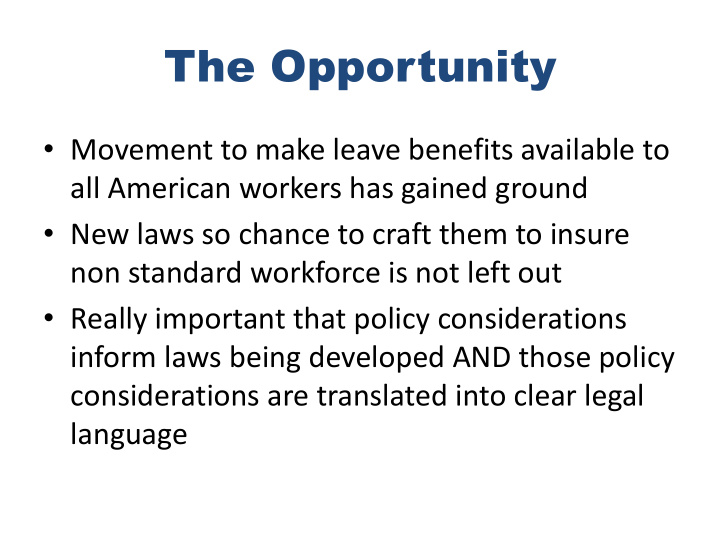



The Opportunity • Movement to make leave benefits available to all American workers has gained ground • New laws so chance to craft them to insure non standard workforce is not left out • Really important that policy considerations inform laws being developed AND those policy considerations are translated into clear legal language
Comparative Overview of PFML Laws Currently in effect Beginning in future years CA NJ NY RI DC WA MA Self- Yes No Yes No Yes Yes Yes employed workers can opt in Number of 52 26 26 30 2 12 20 weeks (own 14 with severe health) pregnancy complications Number of 6 6 Current: 8 4 Family care: 12 12 weeks Fully 6 26 for (family phased in: Bonding: 8 military leave) 12 caregiving Wage 60% to 67% Own 60% 90% of 90% of income 80% of replacemen 70%, (approx.) health: 50% (approx.) income up up to 50% of income up to t rate depending to 40 times the statewide 50% of the on income Family 150% of the average weekly statewide leave: D.C. wage and 50% average Current: minimum of income weekly wage 50% wage and above that and 50% of Fully 50% of amount income phased in: income above that 67% above that amount amount Maximum $1,173 $637 Own $833 $1,000 $1,000 $850 weekly health: This chart offers a summary of key features of state paid family and medical leave laws. For more benefit $170 information on specific state laws, see A Better Balance’s comprehensive comparison chart at (current) https://www.abetterbalance.org/resources/paid-family-leave-laws-chart/. Family leave: $652.96
PFL: A MODEL FOR INCLUSION OF ALL WORKERS • Ideal way to cover workers left out of the traditional employee definition • Need not be tied to traditional view of what an employee/employer relationship is • Can be “portable” from job to job • Broad coverage: – Programs cover full-time and part-time workers – Not contingent on business size – Most programs workers are covered regardless of citizenship or immigration status.
ISSUES TO CONSIDER • Full inclusion as a major goal • Opt in or mandatory coverage • Who pays? • Protecting against long employment duration and earnings requirements • Protecting against long waiting periods • Outreach and education • New ideas, eg. MA coverage of 1099 workers
LESSONS LEARNED • Need policy research and imagination • Need real intentionality and understanding in drafting laws that take into consideration all the concerns of the emerging workforce • Need organizing on the ground and education at the bargaining table emphasizing how important these issues are • Need to be willing to go back and re-examine as we learn more about the non-standard workforce
Recommend
More recommend